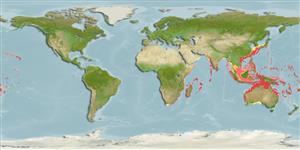Common names from other countries
分类 / Names
俗名 | 同种异名 | Catalog of Fishes(属, 种) | ITIS | CoL | WoRMS | Cloffa
Teleostei >
Acanthuriformes (Surgeonfishes)
鱸形目 (Surgeonfishes) >
Acanthuridae (Surgeonfishes, tangs, unicornfishes)
刺尾鯛科 (Surgeonfishes, tangs, unicornfishes) > Acanthurinae
Etymology: Acanthurus: Greek, akantha = thorn + Greek, oura = tail (Ref. 45335).
More on author: Valenciennes.
Environment: milieu / climate zone / depth range / distribution range
生态学
海洋 礁区鱼类; 深度上下限 4 - 131 m (Ref. 9710), usually 9 - 130 m (Ref. 27115). 热带; 24°C - 28°C (Ref. 27115); 40°N - 37°S, 17°E - 155°W
Indo-Pacific: East Africa (including the Mascarene Islands, Ref. 37792) to the Hawaiian and Line islands, north to southern Japan, south to Rowley Shoals, southern Great Barrier Reef and Lord Howe Island. Absent from most of central Pacific.
印度-太平洋: 东非 (包括玛斯科林岛, 参考文献 37792) 到夏威夷与列岛群岛, 北至日本南部, 南至罗雷浅滩,大堡礁的南方与罗得豪岛。 大部分的中太平洋没有出现。
大小 / 重量 / 年龄
Maturity: Lm ? range ? - ? cm
Max length : 54.0 cm TL 雄鱼/尚未辨别雌雄; (Ref. 3145); common length : 35.0 cm TL 雄鱼/尚未辨别雌雄; (Ref. 3146); 最大年龄: 30 年 (Ref. 127555)
背棘 (总数) : 9; 背的软条 (总数) : 25 - 27; 臀棘: 3; 臀鳍软条: 24 - 26. Pale brown body; broader, irregular lines on head; orange band between eyes, continued behind each eye to gill cover. Each side of caudal peduncle with single, sharp, forward-pointing erectile spine; spine largely covered by cream sheath; groove surrounded by a black area. Dorsal fin with soft part having longer base than spinous part. Minute scales. Gill rakers 22-26 in anterior row, 23-27 in posterior row. Caudal fin lunate in adults (Ref. 1602).
白褐色身体; 在头部上的比较宽又不规则的线; 在眼之间的橘色条纹, 跟鳃盖继续在后每个眼。 尾梗两边有单一个,锐利地, 朝向前面的直立硬棘; 棘主要地被乳黄色的鞘盖着了; 凹槽被一个黑色的区域包围了。 背鳍有软棘的部位超过硬棘的部分有较长的基底。 细小的鳞片。 在前面的列中鳃耙 22-26,23-27 在后列中。 尾鳍新月状的当成鱼时.(参考文献 1602)
Schooling species, usually occurring in seaward reefs at depths greater than 9 m (Ref. 1602). Adults mainly on deep coastal reef slopes and outer reef walls, often on deep shipwrecks. Juveniles found on algae-rocky reef (Ref. 48637). Benthopelagic (Ref. 58302). Occur singly or in groups (Ref. 37816). Feed on surface film of fine green and blue-green algae, diatoms, and detritus covering sand (Ref. 1602). Pair-spawner (Ref. 37816). Mainly diurnal. (Ref. 1602). Utilized as a food fish (Ref. 3146).
一个群游性鱼种, 通常在深度大于 9 公尺出现在临海礁石.(参考文献 1602) 在深地海岸的礁斜坡与外围礁石墙壁上的成鱼主要, 时常深地遇海难之上。 Juviniles 发现于藻类了-岩石的礁.(参考文献 48637) 各别地生存或成群.(参考文献 37816) 吃细小的绿藻与蓝绿藻,硅藻的表面薄膜,与碎屑覆盖沙子。 (参考文献 1602) 它是一个成对产卵者。 (参考文献 37816) 它是主要日行性。 (参考文献 1602). 作为食用鱼.(参考文献 3146)
Life cycle and mating behavior
Maturities | 繁殖 | Spawnings | Egg(s) | Fecundities | 仔鱼
Probably spawn in pairs (Ref. 240).印度-太平洋: 东非 (包括玛斯科林岛, 参考文献 37792) 到夏威夷与列岛群岛, 北至日本南部, 南至罗雷浅滩,大堡礁的南方与罗得豪岛。 大部分的中太平洋没有出现。
Randall, J.E., 1986. Acanthuridae. p. 811-823. In M.M. Smith and P.C. Heemstra (eds.) Smiths' sea fishes. Springer-Verlag, Berlin. (Ref. 3145)
CITES (Ref. 128078)
Not Evaluated
人类利用
渔业: 低经济; 水族馆: 商业性
工具
特别资料
下载 XML
网络资源
Estimates based on models
Preferred temperature (Ref.
115969): 20.3 - 28.9, mean 27.2 (based on 2904 cells).
Phylogenetic diversity index (Ref.
82804): PD
50 = 0.5000 [Uniqueness, from 0.5 = low to 2.0 = high].
Bayesian length-weight: a=0.03020 (0.01872 - 0.04873), b=2.94 (2.80 - 3.08), in cm Total Length, based on LWR estimates for this species & Genus-body shape (Ref.
93245).
营养阶层 (Ref.
69278): 2.0 ±0.00 se; based on food items.
回复力 (Ref.
120179): 低的, 最小族群倍增时间4.5 - 14 年 (tmax=28; K=0.29).
Fishing Vulnerability (Ref.
59153): Moderate vulnerability (36 of 100).
